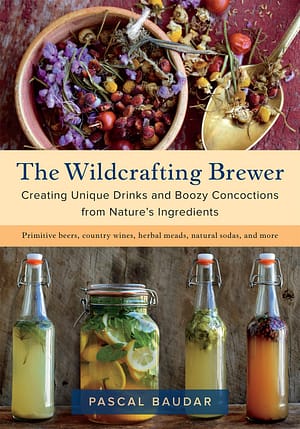Winter in the Forest Beer: Creating Unique Drinks from Nature’s Ingredients

The art of brewing can explore far beyond the usual ingredients into a vast and luminous galaxy of wild and cultivated fruits, berries, grains, and herbs, which once provided a variety of fermented drinks as broad as the world. Now fermentation fans and home brewers can rediscover these “primitive” drinks and their unique flavors in, the newly released, The Wildcrafting Brewer. You’ll be surprised at how easy making your own natural drinks can be!
Each environment has its unique flora and ecosystem. From a culinary perspective, if you know enough about the edible plants and animals living in a specific region, you can create a fermented drink representing it.
There are no real rules. Let it be about fun, creativity, and flavors. What fun flavors will your environment develop? There’s only one way to find out.
Check out the “wonders” of brewing in the excerpt adapted for the web below from The Wildcrafting Brewer by Pascal Baudar.
Winter in the Forest Beer
This recipe is ever-changing with the seasons, but it’s a good example of a winter forest beer. It looks very much as if I just took leaves, twigs, and herbs directly from the forest floor itself, but every ingredient, even fall leaves, was carefully chosen and contributes to the flavor profile.
My first attempts at creating such beers were a bit so-so but they have vastly improved over time. Presently, the end result is somewhere between a beer and a cider—a bit sour, like some wild-yeast-fermented Belgium beers, but delicious. I don’t think you could match this recipe with your own local forest, but maybe this will inspire you to experiment with what your wild terroir has to offer.
1-gallon water (3.78 L)
0.2 ounce (around 3 g) mixed fall leaves (cottonwood, alder, and willow)
0.2 ounce (around 3 g) forest grass—regular grass growing in the forest
2 lemons
1 ounce (28 g) manzanita berries
0.1 ounce (1.5 g) California sagebrush
0.2 ounce (around 3 g) dried mugwort leaves
0.3 ounce (around 8.5 g) turkey tail mushrooms
1¼ pounds (567 g) dark brown sugar
3 large lemons
Commercial beer yeast or wild yeast starter
Procedure
Combine all the ingredients except the lemons and yeast. Cut and squeeze the lemons into the solution. Bring to a boil in a large pot for 30 minutes. Remove from the heat and cool to 70°F (21°C), then add the yeast. When I’m using a wild yeast starter, I usually use ½ to ¾ cup (120–180 ml) of liquid.
Strain into the fermenter. Place the airlock and let it ferment for 10 days. Start counting when the fermentation is active (this may take 2 to 3 days with a wild yeast starter).
Siphon into 16-ounce (473 ml) swing-top beer bottles (you’ll need seven bottles) and prime each one with ½ teaspoon (2 g) white or brown sugar for carbonation. Close the bottles and store in a place that’s not too hot. The beer will be ready to drink in 3 to 4 weeks.
Would you like to explore the smell of the forest after the rain or the sweet fragrance of its rich soil? Maybe add a small amount of candy cap mushroom or bitter decomposing leaves (willow, alder). I like using turkey tail mushrooms, not just for their bitter flavors but also for their medicinal qualities.
Recommended Reads
Recent Articles
Nothing says “spring” like a fresh, foraged meal! Savor the flavors of the season with this Milkweed Bud Pizza recipe.
Read MoreOxeye daisies are one of the most important plants for pollinators including beetles, ants, and moths that use oxeye daisies as a source of pollen and nectar. Instead of thinking about removing a plant like oxeye daisy, consider how you can improve the fertility and diversity of habitat resources in your home landscape, garden, or…
Read MoreSo you want to start reaping your harvest, but you’re not sure where to start? Learn how to break down the options of harvesting tools!
Read MoreWhat’s so great about oyster mushrooms? First, you can add them to the list of foods that can be grown indoors! They are tasty, easy to grow, multiply fast, and they love a variety of substrates, making oyster mushrooms the premium choice. The following is an excerpt from Fresh Food from Small Spaces by R. J.…
Read More








